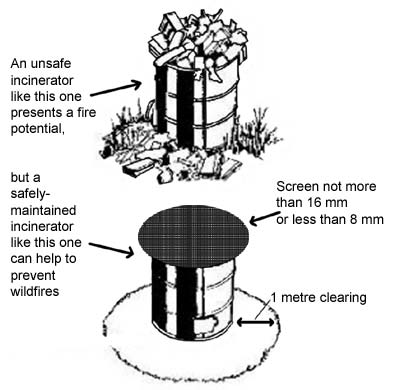Authorized Incinerator:
An Authorized Incinerator is one that is maintained in a condition that provides for proper combustion of any material burned.
The permit holder must always supervise the incinerator and have water on hand at the site.
Materials that should NOT be burned in an incinerator include: tires, plastics, drywall, demolition waste, domestic refuse, asphalt, special waste, biomedical waste, treated lumber, railway ties, manure, rubber, paint, tar paper, fuel & lubricant containers.
Basically, an incinerator is for paper and cardboard that people don’t wish to recycle or shred, and dry small yard waste branches etc. that they are not incorporating into a yard waste pile.
The Authorized incinerator must be located at least 2m (6 ft.) from any dry grass, shrubbery, or wooden fences, and/or 4.5m (15 ft.) from any building.
The incinerator must have a mesh screen where the mesh weave measures not more then 16mm or less than 8mm.

Remember these points when burning:
- Burn only during safe conditions... no wind and after rain has fallen is best
- Stay with fire until it is completely out
- Always have a garden hose available to prevent fire from spreading
- Avoid burning near buildings, trees or tall grass
- Keep fires small and under control
- Recycle and re-use applicable materials before burning
- Check the Fire Hall Fire Hazard Board located opposite the ferry off-ramp, or this website, for updates on the local forest fire hazard
- Remember to get a permit BEFORE you burn
top of page
Campfires
If you are a regular campfire aficionado , we encourage you to look into purchasing an approved propane campfire appliance for the coming years. They are safe, create no sparks, and give you the campfire ambiance you want. During a Complete Fire Ban these appliances are allowed if CSA or UL approved. The type of extended hot dry summer we are experiencing this year (2015) is forecast to be the norm. Open fires will be extremely curtailed or prohibited in the region.
This is a good comparison chart when shopping for a CSA approved propane campfire: http://www.campfirecompare.com/comparison_chart.html
If you want a wood campfire, and they are currently allowed with a permit, the following information is taken from the B.C. Forestry Service website:
Category 1 Open Fire (Campfires):
General Guide to Responsible Burning
Careless use of campfires is one of the leading causes of forest fires. Campfires (Category 1 open fire) must comply with the requirements of the Wildfire Regulation.
There are times when fires should not be lit. Fires should not be lit or allowed to continue to burn when the:
- wind is strong enough to cause sparks to be carried to other combustible material; or
- when a notice banning or restricting the use of campfires is in effect.
When building your campfire:
- Select your campsite carefully and with full regard for safety.
- Prepare your campfire by removing all leaves, twigs and other flammable material around the fire.
- Be sure to scrape or dig down to mineral soil.
- Build your campfires a safe distance (at least 3 metres) from any log, stump, snag, or standing tree or other flammable material, and at least 4 metres from any buildings.
- The size of the campfire must not exceed one half metre in height and one half metre in diameter. The best cooking fire is small and hot.
- Equip yourself with adequate tools and water. These must be kept near the fire at all times.
- Attend your campfire at all times and be certain it is extinguished before leaving it. Sift the ashes with your fingers to be sure.
If your fire escapes
or you require assistance containing your fire
call 9-1-1
or the TIVFD Duty Officer at
250-252-0228.